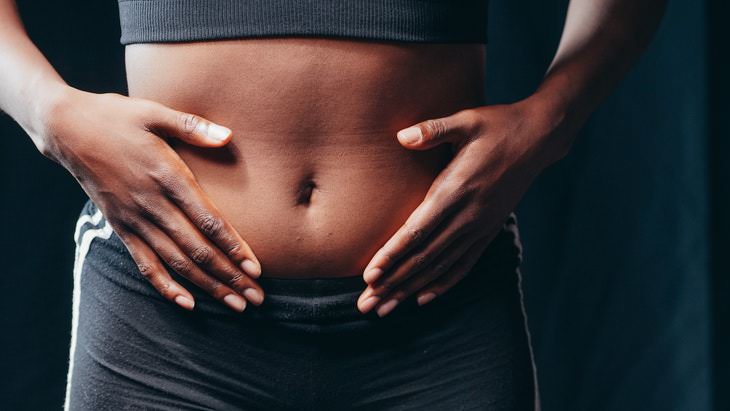1. Deep breathing through the belly

Deep breathing through the belly engages the diaphragm, a flat muscle spanning across the bottom of the ribcage. Learning to breathe by engaging the diaphragm in addition to the chest muscles is important for deepening and slowing down the breath, which is beneficial for improving concentration and alleviating stress. Learning this technique is rather easy and safe for anyone willing to give it a go. Like any exercise, it takes practice and time, so don’t worry if you don’t see results right away.
Here’s how to breathe through the belly:
1. Sit down in a comfortable position. Put one hand on your chest and the other underneath your ribcage.
2. Inhale deeply through the nose, and then exhale completely through the mouth, engaging your belly muscles to push out the air. If you’re doing the exercise correctly, you should feel with your hands that your belly is expanding and contracting, but the ribcage is staying relatively still.
3. Repeat these steps 5 to 10 times.
2. Roll breathing

Anxiety and stress can manifest themselves through shortness of breath. Sometimes, extreme anxiety can develop into a panic attack, which is characterized by increased heart rate and breathlessness. Roll breathing can help you regain your full lung capacity and make you calmer overall by gradually activating all breathing muscles.
We recommend that you practice this breathing exercise laying down because it can make some people a little lightheaded. Practice roll breathing as slowly as you can to garner calmness. Always inhale through the nose and exhale through the mouth.
How to practice roll breathing:
1. Lie down and start by practicing belly breathing and filling your lower lungs with air. See the previous exercise for instructions. Repeat 8-10 times.
2. Now switch to starting an inhale from the lower lungs and then continuing the inhale through the upper chest and the upper lungs. The exhale should also begin by tightening the belly and then continuing to breathe out through the chest - like a wave. Pursing your lips and making a whooshing sound helps you breathe out more fully as well.
3. Practice this breathing technique for 3-5 minutes. In the end, you should feel more focused and relaxed.
Related Article: These Breathing Exercises Will Ease Hot Flashes
3. The Wim Hof Method

Are you familiar with Wim Hof? The Dutch extreme athlete is well known for incredible feats like climbing Mt. Kilimanjaro in shorts and running a marathon barefoot on ice and snow. Learn more about the 62-year-old athlete here - Is It Possible to Control Your Immune System?
Hof says that he wouldn’t be able to achieve any of this without the breathing exercise he had developed. This technique involves holding deep breaths for extended periods of time as a way to increase resilience to both physical and mental stressors. This method is also known to increase energy levels and concentration. Due to the fact that this exercise requires you to hold your breath for a long time, it could potentially make some people lose consciousness. For this reason, it’s important to try this technique while lying down.
How to do the Wim Hof method:
1. Lie down in a safe environment and start by breathing in and out 30-40 times. The ending breath should be as deep as you can take.
2. With an open mouth, exhale completely and hold. The time you’ll be able to hold your breath without inhaling depends on your body’s fitness and practice.
3. Breathe in when you feel that you need it. Finish the exercise by taking one more slow and deep inhale and exhale. It’s normal to experience a tingling sensation or slight lightheadedness after the exercise.
4. Nadi Shodhana - alternate nostril breathing
Alternate nostril breathing (or Nadi Shodhana) is a pranayama exercise, which is the name for yogic breathing techniques. This technique has many proven benefits and is widely used in therapy to promote focus, relaxation, stress relief, and mindfulness. As the name suggests, alternate nostril breathing involves alternating between the nostrils as you inhale and exhale. The technique activates the nervous system, improves breathing, alleviates stress and anxiety, and lowers blood pressure.
Here’s how to practice Nadi Shodhana:
1. Sit down in a comfortable seat and close the left nostril with your left thumb. Slowly inhale through the right nostril.
2. At the peak of the inhalation, pause for a second while closing the right nostril with the left ring finger. Finally, open up the left nostril and exhale through it.
3. Repeat the same steps on the other side. Continue switching sides and doing this exercise for 2-3 minutes.
5. Birthday candle breathing
When you’re feeling anxious, you could start hyperventilating, which upsets the balance of oxygen and carbon dioxide in the blood and makes you feel breathless or dizzy. This exercise is especially beneficial for those cases, or whenever you are feeling worried or anxious.
As the name suggests, this exercise mimics the movement of your lips when you’re trying to blow out a candle. This exercise is easy and effective - simply purse your lips when you exhale, and make sure to breathe out as slowly as you can. Continue this exercise for 2-5 minutes, and you’re sure to feel calmer right away.
6. Resonant breathing

Resonant breathing is a practice that requires that you inhale and exhale on a count of 5, making a total of 5 full breaths in 1 minute. This technique is also known as coherent breathing, and it was shown in studies to reduce stress, improved your mood, and increase heart rate variability (HRV) in those with low HRV.
Here’s how to practice resonant breathing yourself:
1. Lie down in a comfortable position, close your eyes.
2. Inhale through your nose for a count of 5 seconds. No need to breathe in too deeply.
3. Exhale for 5 seconds, allowing the air to escape from your lungs slowly and steadily.
4. Continue breathing like this for 5 minutes or up to 10 minutes.
7. Lion's breath
Lion's breath is another pranayama technique. It exhaling with the mouth open wide and tongue out, which is said to be similar to a lion’s yawn. If you can’t picture it, don’t worry - that’s why we included a step-by-step video tutorial that displays this breathing technique in detail. Apart from reducing stress, this pranayama exercise also strengthens your throat muscles, vocal cords, and upper chest muscles.
How to practice Lion’s breath (see video above for a visual guide and further posture tips and variations):
1. Sit up tall in a comfortable seat. Inhale slowly and deeply through your nose.
2. As you exhale, make a long “ha” sound, stick out the tongue, and open your eyes wide.
3. Repeat the breathing cycle 2-3 times.
Share these techniques with others!
 Go to BabaMail
Go to BabaMail






























